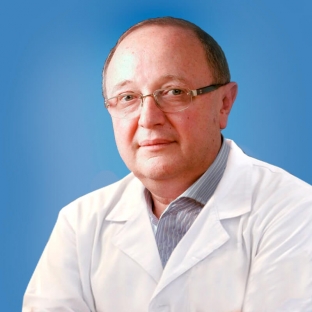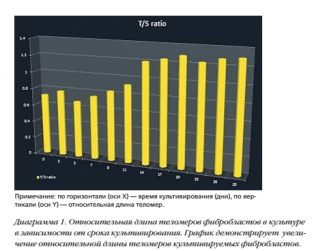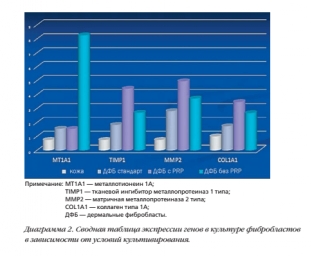Regenerative technologies — one of the most promising areas of development of aesthetic medicine. Today, the greatest interest of researchers and practitioners & nbsp; raise questions about autologous dermal fibroblasts in anti-aging treatments. Tissue regeneration with the use of autofibroblasts is one of the most expensive technologies in the world and has not yet been sufficiently mastered by cosmetologists. Therefore, proven algorithms for their application are of particular value , which allow optimizing costs with a high efficiency of the procedure.
 Vladimir Tsepkolenko, Doctor of Medical Sciences, Professor, Director General of the Ukrainian Institute of Plastic Surgery and Cosmetology "Virtus", told estet-portal.com readers about one of these algorithms.
Vladimir Tsepkolenko, Doctor of Medical Sciences, Professor, Director General of the Ukrainian Institute of Plastic Surgery and Cosmetology "Virtus", told estet-portal.com readers about one of these algorithms.
Studies that confirm effect tissue regeneration using autofibroblasts
Mechanisms of tissue regeneration have been repeatedly described in the world medical literature, since regenerative & nbsp; technologies for today allow you to get as close as possible to the possibility of using natural mechanisms for the treatment of diseases – by stimulating the body's defenses and restoring the normal functioning of the damaged organ. In relation to aesthetic medicine, the study of the mechanisms of tissue regeneration opens up the widest field of possibilities for the safe and effective restoration of the structure of the skin, the correction of age-related changes.
At the end of the 90s of the last century, the American company Isolagen published data on a large-scale clinical study, during which 1 450 patients took part, the observations lasted 24-48 months. The study dealt with the issues of rejuvenation with the help of autofibroblasts of facial skin with severe wrinkles. The results showed an excellent clinical effect in reducing the number of wrinkles and their depth, while there were no complications.
About ten years later, in 2003-2008, another multicenter placebo-controlled study was conducted in which 800 patients participated. The follow-up continued for 12 months and showed a statistically significant reduction in the wrinkle depth index as a result of therapy with autofibroblasts and the maintenance of a long-term effect.
The result of the research was the FDA license, which was received by the method of using autofibroblasts for skin rejuvenation, as it has confirmed its high efficiency and safety in use.
Today, there are many examples of the successful use of autofibroblasts around the world. Significant progress in this direction was achieved by the scientific team led by V.L. Zorina and A.I. Zorina, a research group headed by N. Mentz, and others. However, despite the obvious effectiveness of the presented method, the use of autofibroblasts in cosmetology practice is significantly limited by the need to introduce them in large quantities to achieve a pronounced clinical effect, which, in turn, affects the cost procedures. This became the starting point for the development by the doctors of the Virtus Institute effective and safe methods of rejuvenation using a minimum number of autofibroblasts.
Use of fibroblasts in tissue regeneration procedures
On the path of researchers studying the use of autofibroblasts, the key point was to address the issue of increasing gene expression, which decreases with age. It is known that the telomere length of human skin fibroblasts decreases by approximately 150 bases with each cell division, which limits the number of cell divisions to an average of 50±10. The same happens in the culture of fibroblasts. In that case, won't we get the "old" fibroblasts instead of young and functionally active?
To answer this important question for the use of autofibroblasts, we conducted special studies, including checking the length of telomeres and gene activity, and also developed epigenetic mechanisms for cultivating autofibroblasts, which made it possible to obtain their active forms for use in practical medicine.
Epigenetic mechanisms of fibroblast cultivation — this is a topic that requires coverage in a separate article, so here I will only give diagrams showing that we managed to achieve a significant increase in the length of telomeres of cultured fibroblasts and an increase in gene expression.


This made it possible to reduce the dosage of the cellular biomaterial. Today in Europe, a two-time injection of 60 million fibroblasts is recommended. The cost of cells only at the exit from the biotechnological laboratory is about 5,000 euros. According to our technology, the number of fibroblasts is limited to 14 million, the cost of production is about 700 euros.
Later we developed and patented a new algorithm for the complex correction of involution-dystrophic skin changes using fibroblasts — procedure that we called neofibrolifting.
Neofibrolifting algorithm
The neofibrolifting procedure consists of two to three main successive stages, based on the impact on the key points of skin aging. The scientific data and the results of our own research support the conclusion that such moments are:
■ reduction of skin hydropower;
■ changes that occur in the three-dimensional organization of the skin and are associated with a decrease in the level of collagen, elastin, reticulin in the dermis;
■ violation of blood microcirculation in the skin;
■ a decrease in the number of fibroblasts in the skin and a weakening of their biosynthetic activity as a result of a deterioration in microcirculation and a decrease in the amount of incoming nutrients.
The number of stages and their content depend on the severity of involutional changes in the skin.
Neofibrolifting procedure algorithm for pronounced age-related skin changes
First stage
Sequentially carried out:
1) ultrasound examination — to assess the condition of the patient's skin, determine its thickness and clarify the structural elements;
2) Doppler ultrasound skin scan — to determine the blood flow velocity;
3) taking a small area of skin — for cultivating the required amount of dermal autofibroblasts in a biotechnological laboratory;
4) injections of autologous plasma enriched with growth factors by mesotherapeutic method, — to stimulate revascularization and create the most favorable conditions for engraftment and functioning of fibroblasts.
The first stage procedures are carried out on the same day, with no interval between skin sampling and PRP administration.
Second stage
The second stage starts in 2 weeks. Carried out in one patient visit:
■ repeat PRP_therapy;
■ laser procedure of ablative fractional photothermolysis — to stimulate skin regeneration processes by creating controlled inflammation, leading to renewal of the skin microstructure, and the most favorable conditions for the introduction of autologous fibroblasts.
Third stage
The third stage is carried out in two weeks — the interval required to obtain the effect of revascularization after the introduction of PRP and skin regeneration after laser exposure. By this time, the process of cell cultivation also ends: it takes 4 weeks from the moment the skin biopsy is taken. Execute sequentially:
1) repeated ultrasound examination of the skin and the study of its blood flow parameters — for the purpose of control;
2) during the same visit of the patient — the introduction of dermal autofibroblasts in the amount of 14 million in 14 ml of platelet-rich plasma, which contributes to the formation of the extracellular matrix and the production of its main structural fibrillar protein — collagen.
Result to achieve — improvement in the appearance of aging skin.
Neofibrolifting procedure algorithm for moderately pronounced age-related skin changes
First stage — the same as for patients with pronounced age-related skin changes.
Second stage — similar to the third stage, provided for with pronounced age-related skin changes; carried out after 4 weeks.







Add a comment